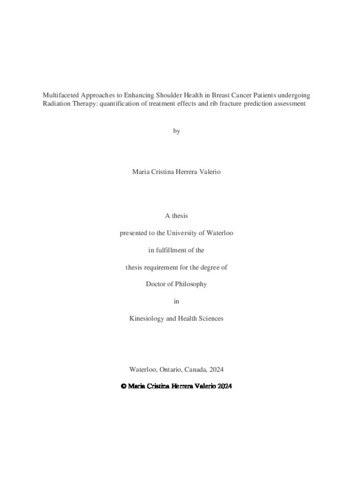| dc.description.abstract | Radiotherapy is a highly effective treatment for breast cancer, but it is also associated with several complications that can impact patients’ quality of life and overall survival. This dissertation addressed the lack of research examining the influence of radiation therapy on shoulder health indicators during the treatment window. Additionally, it investigated the effectiveness of an intervention program focused on shoulder strength to compensate for potential shoulder health impairments. Finally, it assessed the feasibility of using quantitative ultrasound for more accessible evaluations of rib fragility fractures, which may arise as a long-term consequence of radiation therapy.
Study 1 and 2 shared an in vivo experimental collection. Shoulder health indicators of the affected limb of 27 breast cancer patients were tracked at baseline, midpoint, and endpoint assessments within the radiation therapy window. The activation of latissimus dorsi, teres major, pectoralis major, and serratus anterior, were quantified using a wearable electromyography (EMG) device during two shoulder flexion-extension, two shoulder abduction-adduction, and two shoulder external-internal rotation submaximal tasks. The kinematics of the shoulder complex were measured using an Inertial Measurement Unit (IMU) during six maximal range of motion trials involving flexion, abduction, and external rotation. Additionally, arm strength was evaluated using a hand-held dynamometer during flexion, extension, abduction, adduction, external rotation, and internal rotation maximal exertions. Finally, the arm circumference was determined using a measuring tape. Study 1 showed significant changes (p<0.05) in the latissimus dorsi and teres major muscles during all evaluated shoulder movement tasks. There was also a significant reduction (p<0.05) in shoulder abduction at the end of treatment compared to baseline. No changes were noted in pectoralis major and serratus anterior muscles, nor in arm strength. Radiation dose was negatively correlated with shoulder abduction range of motion. Study 2 evaluated and compared a control group with a shoulder strength intervention group throughout the radiation treatment. The intervention group exhibited higher activation of teres major and serratus anterior compared with control group (p < 0.05) in external- internal rotation and flexion-extension movement tasks. This group also exhibited significantly greater (p<0.05) arm strength and negative correlations between radiation fractions and arm strength for all the evaluated movements. No significant differences were noted in pectoralis major and latissimus dorsi activation, nor shoulder complex range of motion between the groups.
Study 3 employed an in-silico approach to simulate oncological treatments and demonstrated that Quantitative Ultrasound Imaging of Bone (QUSIB) is sensitive to the structural changes induced by these therapies. Specifically, two sets of ribs were created to simulate the effects of 5 years of radiation and bisphosphonate treatments. Acoustic attenuation and backscatter coefficient parameters were examined to assess their ability to detect changes in trabecular structure. The results revealed significant correlations (p<0.05) between the observed and predicted values of Bone Volume Fraction (BV/TV). Furthermore, significant differences (p<0.05) were observed in trabecular thickness between the base and simulated radiation and bisphosphonate models.
This dissertation provides valuable insights into the effects of radiation therapy on shoulder functionality. It aims to help patients minimize the potential side effects of this treatment and assist health providers in finding more accessible solutions for managing these long-term consequences. | en |

